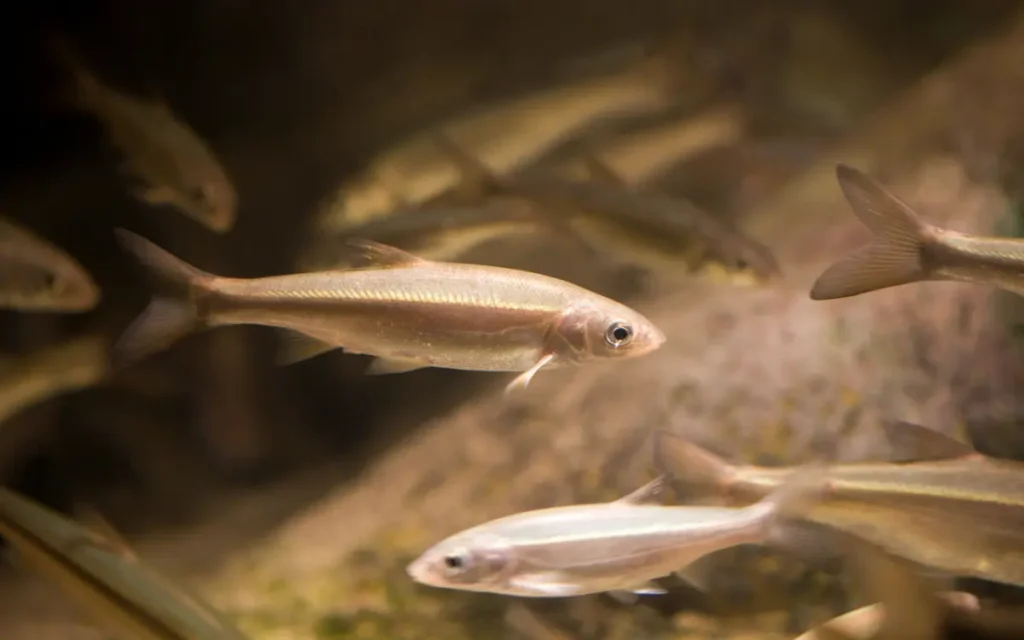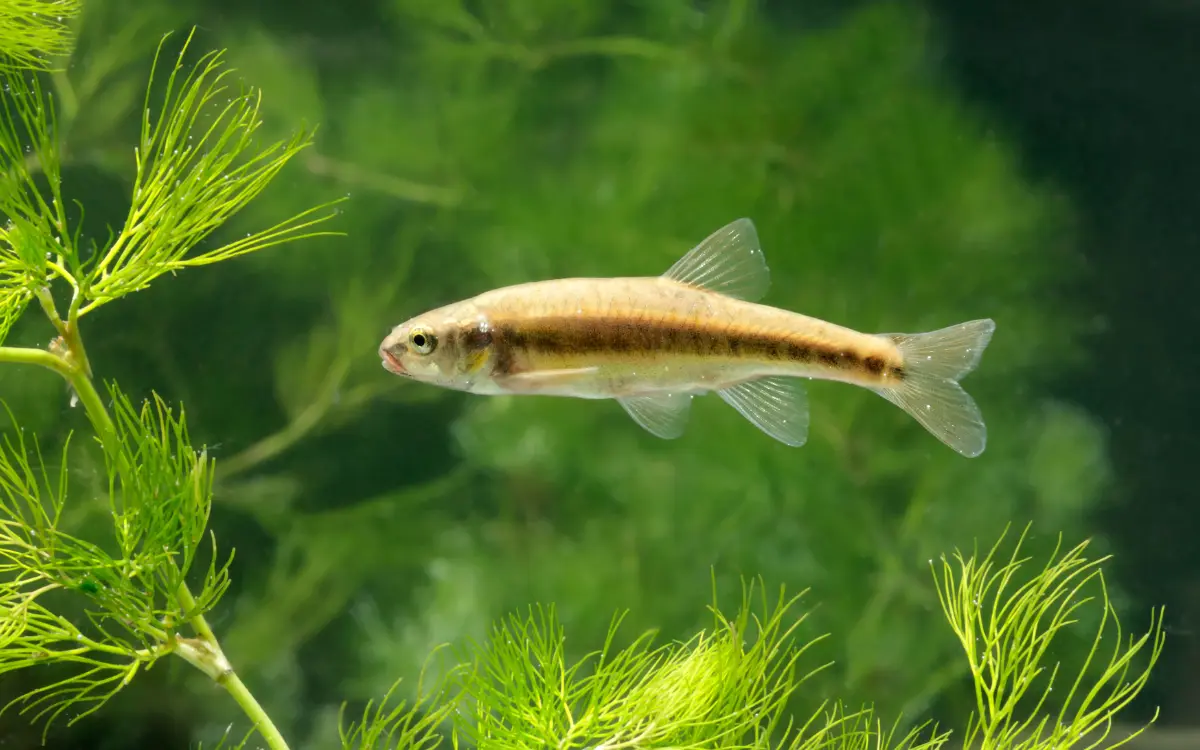The White Cloud Mountain Minnow is a small, hardy freshwater fish known for its vibrant colors and peaceful nature, making it an ideal choice for beginner aquarists seeking a lively addition to their community tanks.
| Attribute | Details |
| Family | Cyprinidae |
| Aggressiveness | Peaceful |
| Minimum Tank Size | 10 gallons (37 liters) |
| Life Span | 5-7 years |
| Diet | Omnivore (flakes, pellets, small live or frozen foods) |
| Size | Up to 1.5 inches (4 cm) |
| Compatibility | Compatible with other small, peaceful fish |
| Temperament | Active, social, schooling fish |
Tank Setup for White Cloud Mountain Minnow

Tank Size:
A minimum of 10 gallons (37 liters) is recommended to provide enough space for a small school of White Cloud Mountain Minnows.
Substrate:
Use fine gravel or sand as the substrate to mimic their natural environment and support plant growth.
Plants:
Include live plants like Java moss, Anubias, and Hornwort. These plants provide hiding spots and contribute to a healthy tank ecosystem.
Decor:
Add driftwood, rocks, and other decorations to create hiding spots and simulate a natural habitat. These structures also help reduce stress and enhance the aesthetic appeal of the tank.
Water Temperature:
Maintain the water temperature between 64-72°F (18-22°C). White Cloud Mountain Minnows thrive in cooler water compared to many other tropical fish.
Water pH:
Keep the pH level between 6.0 and 8.0. This range is suitable for their health and well-being.
Water Hardness:
The ideal water hardness should be between 5-19 dGH to replicate their natural conditions.
Lighting:
Provide moderate lighting, ensuring it is not too intense. Avoid placing the tank in direct sunlight to prevent algae growth and overheating.
Filtration:
Use gentle filtration, such as sponge filters, to maintain clean water without creating strong currents. White Cloud Mountain Minnows prefer calm water.
Aeration:
Ensure moderate aeration to keep the water well-oxygenated. This can be achieved with an air pump or by positioning the filter output to agitate the water surface.
Water Changes:
Perform weekly water changes of 20-25% to maintain optimal water quality. Regular maintenance helps prevent the buildup of harmful substances.
Tank Mates:
Choose other small, peaceful fish as tank mates. Suitable companions include Neon Tetras, Guppies, and Corydoras catfish. Avoid aggressive species that may stress or harm the minnows.
Feeding White Cloud Mountain Minnow
Diet:
White Cloud Mountain Minnows are omnivores, meaning they eat both plant and animal matter. Their diet should be varied to ensure they receive all necessary nutrients.
Flake Food:
High-quality flake food should be the staple of their diet. Choose a product specifically formulated for small tropical fish to ensure it contains the right balance of nutrients.
Pellets:
Micro pellets can also be offered as an alternative to flake food. These are especially good for ensuring that fish get a well-rounded diet.
Live Food:
Incorporate live foods like brine shrimp, daphnia, and bloodworms occasionally. Live foods are excellent for stimulating natural hunting behaviors and providing high-quality protein.
Frozen Food:
Frozen versions of live foods, such as frozen brine shrimp and bloodworms, are convenient alternatives. These can be easily stored and defrosted when needed.
Vegetable Matter:
Blanched vegetables like spinach or peas can be offered occasionally. This helps to provide necessary plant-based nutrients and fiber.
Feeding Frequency:
Feed your White Cloud Mountain Minnows small amounts 1-2 times daily. It’s better to feed them smaller portions multiple times a day than a large amount once, as this prevents overfeeding and ensures all fish get a chance to eat.
Portion Size:
Only provide as much food as they can consume in 2-3 minutes. Overfeeding can lead to water quality issues and health problems for the fish.
Supplementary Foods:
Occasionally add specialized foods like spirulina flakes or high-protein fry food to diversify their diet and support their health, especially if you are breeding them.
Observation:
Regularly observe your fish during feeding to ensure all individuals are eating properly. This can help you spot any potential health issues early.
Breeding White Cloud Mountain Minnow
Tank Setup for Breeding:
- Separate Breeding Tank: Set up a separate breeding tank with a minimum size of 5 gallons (19 liters). This helps protect the fry from being eaten by other fish.
- Substrate: Use fine gravel or marbles to cover the bottom. This allows the eggs to fall between the gaps, protecting them from being eaten by the adults.
- Plants and Decorations: Add plenty of live plants, such as Java moss or spawning mops, which provide hiding places for the eggs and fry.
- Water Conditions: Maintain the water temperature between 64-72°F (18-22°C), with a pH of 6.0-8.0 and a hardness of 5-19 dGH.
Conditioning the Fish:
- Select Healthy Breeders: Choose a healthy pair or a small group of White Cloud Mountain Minnows. Males are typically more colorful and slender, while females are rounder, especially when full of eggs.
- Feed High-Quality Food: Condition the breeders by feeding them a varied diet of high-quality flake food, live foods (like brine shrimp and daphnia), and frozen foods to encourage spawning.
Spawning Process:
- Introduce Breeders: Introduce the conditioned fish to the breeding tank. It’s best to have a ratio of one male to two females to increase the chances of successful breeding.
- Monitor for Spawning: Spawning usually occurs early in the morning. The male will display vibrant colors and perform a courtship dance to attract the female. Once the female is receptive, she will release eggs, which the male will fertilize.
After Spawning:
- Remove Adults: Once spawning is complete, remove the adults from the breeding tank to prevent them from eating the eggs.
- Egg Care: The eggs will hatch in about 48-60 hours, depending on the water temperature.
Raising Fry:
- Feeding: Once the fry are free-swimming, typically after 3-4 days, start feeding them infusoria or commercially available liquid fry food. As they grow, transition them to finely crushed flake food or powdered fry food.
- Water Quality: Maintain excellent water quality by performing regular water changes. Use an air-driven sponge filter to provide gentle filtration without harming the fry.
Growth and Development:
- Monitor Growth: Keep an eye on the fry’s growth and health. Separate any significantly larger individuals to prevent bullying and ensure even growth.
- Transition to Main Tank: Once the fry are large enough not to be eaten (usually around 1 inch or 2.5 cm), they can be gradually acclimated and introduced to the main tank.
White Cloud Mountain Minnow Tank Mates
- Neon Tetras
- Guppies
- Corydoras Catfish
- Harlequin Rasboras
- Zebra Danios
FAQ’s
Can minnows live with bettas?
White Cloud Mountain Minnows can potentially live with bettas, but it’s essential to monitor their interactions closely. Bettas can be aggressive, and their long fins might be nipped by the active minnows. Provide plenty of hiding spots and space to reduce stress.
How big do white cloud fish get?
White Cloud Mountain Minnows typically grow to about 1.5 inches (4 cm) in length, making them a suitable choice for small to medium-sized aquariums.
Do minnows need oxygen?
Yes, minnows, including White Cloud Mountain Minnows, require well-oxygenated water to thrive. Using an air pump or ensuring good water movement with a filter can help maintain appropriate oxygen levels.
Are white cloud mountain minnows good?
White Cloud Mountain Minnows are excellent aquarium fish. They are hardy, peaceful, and easy to care for, making them a great choice for both beginner and experienced aquarists.
Do white cloud fish eat algae?
While White Cloud Mountain Minnows may nibble on algae occasionally, they are not efficient algae eaters. Their diet should primarily consist of high-quality flake food, live foods, and frozen foods. For algae control, consider adding dedicated algae-eating species to the tank.

